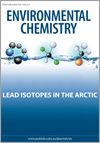Environmental context. Lead is a toxic trace element, widely distributed in the Arctic environment as the result of both natural and anthropogenic processes. High-precision measurements of lead’s isotopic composition are used to distinguish the possible sources and track the transport pathways of this toxic metal. These measurements can provide unique global information on the history and status of lead contamination.

Environmental Chemistry
Volume 17 Number 3 2020
Environmental context. Estuaries play an important role in global carbon cycling in terms of transforming dissolved organic matter (DOM). We describe the molecular composition and spatial distribution of DOM in the Pearl River Estuary, an area severely impacted by anthropogenic activities, and show how DOM composition gradually changes with salinity. The results will help our understanding of the sources and transformations of anthropogenic DOM discharged to the coastal seas.
EN19198Metal ion binding by humic substances as emergent functions of labile supramolecular assemblies
Environmental context. The fundamental basis for the high flexibility of humic substances is still unclear, though it is crucial for the understanding of metal bioavailability and toxicity in soil and aqueous environments. We show at the molecular level how characteristics of organic matter affect metal binding depending on the environmental conditions. Such understanding will help in the modulation of metal availability in soil and water in changing environmental situations.
Environmental context. Following stringent regulations, based on environmental health concerns, for controlling the production and usage of bisphenol A, several analogues have been developed as replacement chemicals. These analogues are now found in environmental samples at similar or even higher concentrations than bisphenol A. We report a sensitive and easy-to-perform analytical method for the determination of 11 bisphenols in vegetables.
EN19171Monod-based ‘single-data’ strategy for biodegradation screening tests
Environmental context. Obtaining biodegradation data over time can be difficult, especially when dealing with environmental compartments of increasing complexity. We evaluated the possibility of obtaining a full biodegradation depletion curve from a single biodegradation-time experimental measurement, and found that environmental information related to potential chemical persistence can be derived. The applicability of this ‘single-data’ strategy is illustrated using simulated and experimental data for several compounds.
EN19213Lipids that contain arsenic in the Mediterranean mussel, Mytilus galloprovincialis
 , Georg Raber, Kenneth B. Jensen, António J. A. Nogueira and Kevin A. Francesconi
, Georg Raber, Kenneth B. Jensen, António J. A. Nogueira and Kevin A. Francesconi
Environmental context. Although arsenic-containing lipids are widespread in marine environments, their origin remains unknown. We show that the arsenolipids in a filter-feeding bivalve mollusc closely match those found in marine food sources, including unicellular algae and bacteria. The results demonstrate the role of lower trophic levels in determining the forms of arsenic found in higher organisms.



